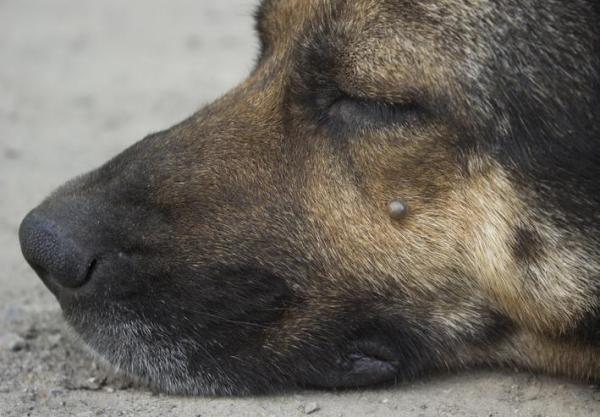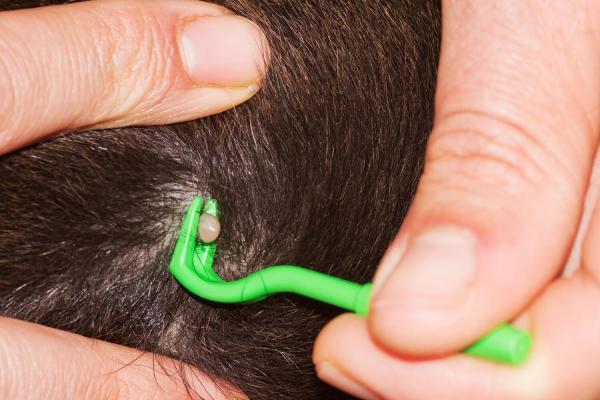
When walking our dog in long grass, we often check for ticks afterwards. While the bites they cause on our canine's skin can be annoying, it is not the bite itself which causes concern. The worry is the pathogens which can be passed on via the tick's saliva. One such pathogen is bacteria from the genus Anaplasma. Infection by this bacteria leads to the disease anaplasmosis which is known to affect mammals such as cattle, horses and dogs.
At AnimalWised, we take a closer look at anaplasmosis in dogs. More specifically, the better understand the causes, symptoms and treatment of the disease in our canine. We also look at management of the disease and prevention in dogs which are not infected.
What is anaplasmosis in dogs?
Anaplasmosis in dogs is an infectious disease caused by bacteria of the genus Anaplasma. While these bacteria are the direct cause of anaplasmosis in dogs, the indirect cause is the vector of the bacteria. As a tick-borne disease, canine anaplasmosis occurs due to tick bites on the dog's skin. In this case, it is the tick which is the vector.
Ticks feed on the blood of animals. They do so by using their chelicerae to break the skin and blood vessels of their host. These are long rods on the mouth of the tick with teeth at the end. Once the skin is broken, they assess the chemicals released to see their viability as a host and they attach themselves thoroughly if they want to feed. For this reason, ticks can remain on a dog's skin for days at a time.
Blood not only enters the tick when they feed. Bacteria from the tick can enter the bloodstream of the dog, including Anaplasma. Since ticks remain on the dog's skin to feed for a minimum of 18-24 hours, there is a prolonged opportunity to create an infection. Anaplasma bacteria are obligate intracellular parasites. This means they must live inside cells, in this case they parasitize blood cells. This is what results in symptoms of anaplasmosis.

Anaplasma species which affect dogs
There are various species of anaplasma bacteria. Only two of them are considered a cause of anaplasmosis in dogs, as not all parasitical bacteria share the same host. The anaplasma bacteria which can infect dogs are:
- Anaplasma phagocytophilum: causes what is known as canine granulocytic anaplasmosis[1].
- Anaplasma platys: responsible for infectious cyclic thrombocytopenia.
These are not the only pathogens which can infest ticks. Other tick-borne diseases which can be spread to dogs include Lyme disease (borreliosis) and canine babesiosis which can complicate diagnosis. Diagnosis is first based on clinical signs, although we should be alerted if we find ticks or tick bites on our dog's skin. A blood test for dogs will be carried out to observe for the correct pathogen to determine the proper course of treatment.
At one stage granulocytic anaplasmosis and infectious cyclic thrombocytopenia where not known to be zoonotic, i.e. diseases transferred to humans by dogs. Since the 1990s, cases have been seen in humans. This is a growing concern for both humans and canines since tick-borne diseases appear to be on the rise thanks to climate change and other factors[1].
Symptoms of anaplasmosis in dogs
The symptoms of this disease are numerous, but non-specific. This means they are common in various pathologies, another fact that can complicate diagnosis. In addition, some dogs are asymptomatic or develop only very mild symptoms. Other dogs may remain as chronic carriers. The clinical picture includes the following signs of anaplasmosis in dogs:
- Fever
- Lethargy
- Depression
- Anorexia
- Limp
- Joint pain
- Polyarthritis
- Vomiting
- Diarrhea
- Lack of coordination
- Seizures.
- Lymph node inflammation
- Anemia
- Decreased platelets
- Increased liver enzymes
- Pale mucosa
- Petechiae
- Cough
- Uveitis
- Edema
- Increased water intake
With A. platys, episodes of thrombocytopenia occur. These result a decrease in the number of the dog's platelets, combined with other episodes of recovery at intervals of 1-2 weeks.

Diagnosis of anaplasmosis in dogs
We have seen that the symptoms that can appear in this disease are nonspecific. This means the veterinarian will need to rely on the information we provide about the dog's life habits to achieve a diagnosis of anaplasmosis. This likely includes whether the dog has been in an environment with the presence of ticks. Dogs which have not been properly dewormed are at more risk. This is why we stress the importance of deworming companion animals.
Once anaplasmosis or other parasitical infections are suspected, the veterinarian will take a blood sample. The dog's blood test will be analyzed under a microscope via blood smears. The colonies that form anaplasma are called morulae. When these are viewed, the diagnosis will be confirmed. Other diagnostic methods include serology and PCR.
Treatment of anaplasmosis in dogs
To find out how to treat anaplasmosis in dogs, it is necessary to go to the veterinarian. The treatment of this disease is based on the use of antibiotics and drugs to reduce the symptoms. In addition, it is essential to control ticks by establishing an external deworming schedule agreed with our veterinarian and appropriate to the characteristics of the dog and its way of life.
Can I get anaplasmosis from my dog?
It is important to know that anaplasmosis can also affect humans. The science shows that humans are able to be infected by these bacteria. However, transmission from dogs has not been clinically observed, so the chances are low. It is another important reason why we need to observe for ticks since a tick can be infected by biting the dog and can then bite others.
Does anaplasmosis in dogs go away?
Some tick-borne diseases can persist for the rest of the dog's life. Perhaps the most well-known is Lyme disease in dogs. However, anaplasmosis can be effectively cured with the correct antibiotic treatment. Symptoms should start to recede within 1 to 2 days of treatment.

Prevention of anaplasmosis in dogs
Since ticks are the main vector of anaplasma bacteria, anaplasmosis in dogs is best prevented by avoiding contact with ticks. For this reason, the following measures are contemplated:
- Control of ticks with antiparasitic products, preferably those that are waterproof.
- Avoid places with a high presence of ticks, such as wooded areas, especially at times of the year with a higher incidence of these parasites. Long grass is particularly bad since ticks use the height to attach to the body of the dog.
- Inspect dogs after walks. In order to transmit anaplasma bacteria, ticks must spend many hours attached to them, so their early elimination will prevent contagion.
- If necessary, we will also implement environmental disinfection measures.
Always ensure your dog has the right vaccination and deworming schedule. Speak to your veterinarian if your dog does not have these implemented.

This article is purely informative. AnimalWised does not have the authority to prescribe any veterinary treatment or create a diagnosis. We invite you to take your pet to the veterinarian if they are suffering from any condition or pain.
If you want to read similar articles to Anaplasmosis in Dogs - Causes, Symptoms and Treatment, we recommend you visit our Parasitic diseases category.
1. Atif, F. A., Mehnaz, S., Qamar, M. F., Roheen, T., Sajid, M. S., Ehtisham-Ul-Haque, S., Kashif, M., & Ben Said, M. (2021). Epidemiology, Diagnosis, and Control of Canine Infectious Cyclic Thrombocytopenia and Granulocytic Anaplasmosis: Emerging Diseases of Veterinary and Public Health Significance. Veterinary sciences, 8(12), 312.
https://doi.org/10.3390/vetsci8120312